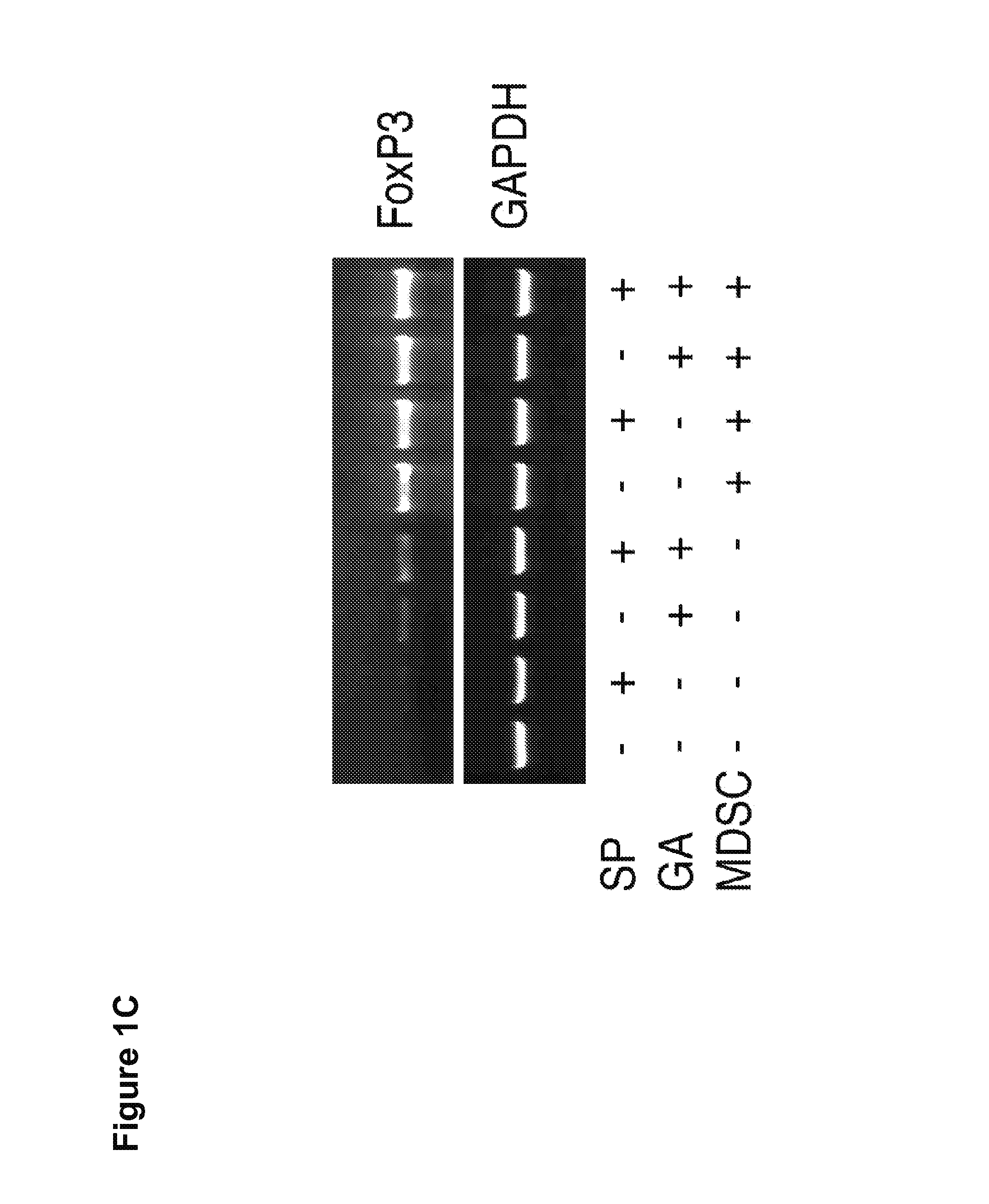Methods of using small compounds to enhance myeloid derived suppressor cell function for treating autoimmune diseases
a technology of suppressor cell and small compound, which is applied in the direction of immunological disorders, antibody medical ingredients, peptide/protein ingredients, etc., can solve the problems of side effects, weight gain, side effects, and kidney toxicity
- Summary
- Abstract
- Description
- Claims
- Application Information
AI Technical Summary
Benefits of technology
Problems solved by technology
Method used
Image
Examples
example 1
The Effects of GA and SP600125 on the Suppressive Functions of MDSCs
[0167]To determine whether GA and SP600125 could further enhance MDSC suppressive function, Gr-1+CD115+ MDSCs were sorted from bone marrow and spleens of tumor-bearing mice and the suppressive activity against HA peptide-mediated-T-cell proliferation was assessed in the presence or absence of GA and SP600125. As shown in FIG. 1A, the highest suppressive effect was observed in the presence of both GA and SP600125, when compared with untreated MDSCs, GA, or SP600125 alone treated MDSCs. The result indicates that the suppressive activity of MDSCs can be further increased by treatment with GA and SP600125.
[0168]It was next evaluated whether GA and SP600125 could increase the Treg cell inducing activity, another suppressive mechanism mediated by MDSCs. Splenocytes from CD4+ HA-TCR transgenic mice were co-cultured with irradiated MDSCs at a ratio of 4:1 in the absence or presence of GA, SP600125, or both. Five days later,...
example 2
GA and SP600125 Cooperate in the Inhibition of MDSC Differentiation In Vitro
[0172]To test whether differentiation of MDSCs can be inhibited or retarded by the treatment of GA, SP600125, or both, Gr-1+CD115+ MDSCs were sorted by MACS and cultured in the absence or presence of GA, SP600125, or both. Twenty-four (24) hours later, viable cells were harvested and stained with anti-CD86, anti-CD80, anti-CD11c, anti-I-A, anti-F4 / 80, or isotype-matched control followed by flow cytometric analysis. As shown in FIG. 4A, sorted Gr-1+CD115+ MDSCs spontaneously differentiated into CD11c+, CD86+ and IA / IE (MHC class II)+ cells and F4 / 80+ cells upon culture for 24 hours in the absence of cytokine or chemokine stimulation. Treatment with GA or SP600125 impaired the spontaneous differentiation of MDSCs, as evidenced by the lower expressions of CD11c, MHC class II, co-stimulatory molecules, and F4 / 80. Treatment with a combination of GA and SP600125 further retarded the differentiation of MDSCs. The r...
example 3
The Therapeutic Effect of MDSCs in Combination Wwth the Treatment of GA and SP600125 in a Murine Model of Inflammatory Bowel Disease
[0175]The therapeutic potential of MDSCs in combination with SP600125 and GA was assessed in a model of DSS (dextran sodium sulfate)-induced IBD. The ability of MDSCs and GA and SP600125 to suppress DSS-induced colitis was tested. Mice were left untreated or treated with sorted MDSCs (5×106 cells / mouse) alone or in combination with GA, SP600125, or both on the day of disease induction. C57BL / 6 mice were fed with water containing 3.5% DSS from day 0 to day 11. Mice were injected intraperitoneally with SP600125 (5 μM for i.p. injection) or subcutaneously with 600 μg / kg GA or control PBS from day 0 to day 11. Some mice also received adoptive transfer of MDSCs (5×106 cells / mouse) via tail vein on days 0 and 7.
[0176]The severity of colitis was quantified as the clinical score by assessing stool consistency, bleeding, and weight loss, which ranges from 0 (hea...
PUM
| Property | Measurement | Unit |
|---|---|---|
| average molecular weight | aaaaa | aaaaa |
| body weight | aaaaa | aaaaa |
| size | aaaaa | aaaaa |
Abstract
Description
Claims
Application Information
 Login to View More
Login to View More - R&D
- Intellectual Property
- Life Sciences
- Materials
- Tech Scout
- Unparalleled Data Quality
- Higher Quality Content
- 60% Fewer Hallucinations
Browse by: Latest US Patents, China's latest patents, Technical Efficacy Thesaurus, Application Domain, Technology Topic, Popular Technical Reports.
© 2025 PatSnap. All rights reserved.Legal|Privacy policy|Modern Slavery Act Transparency Statement|Sitemap|About US| Contact US: help@patsnap.com



